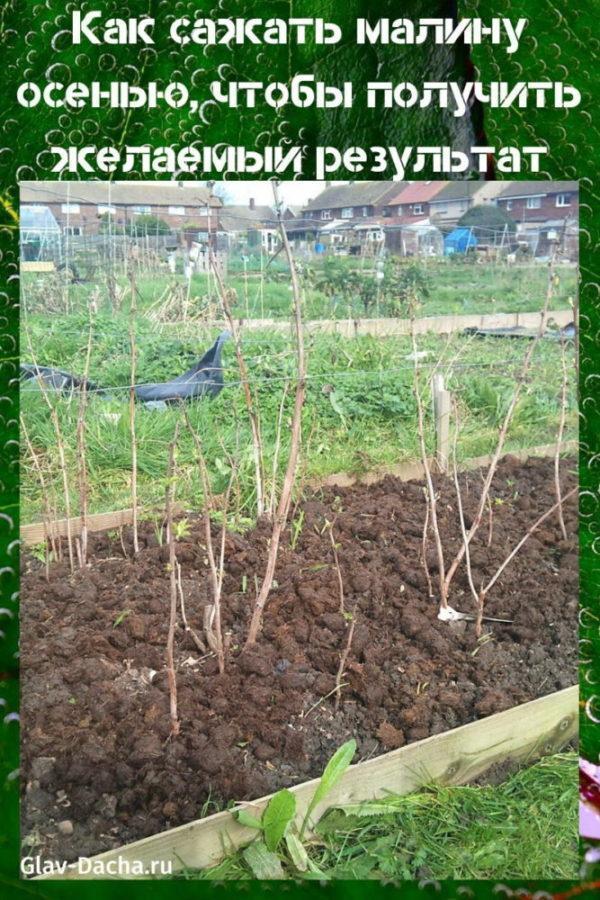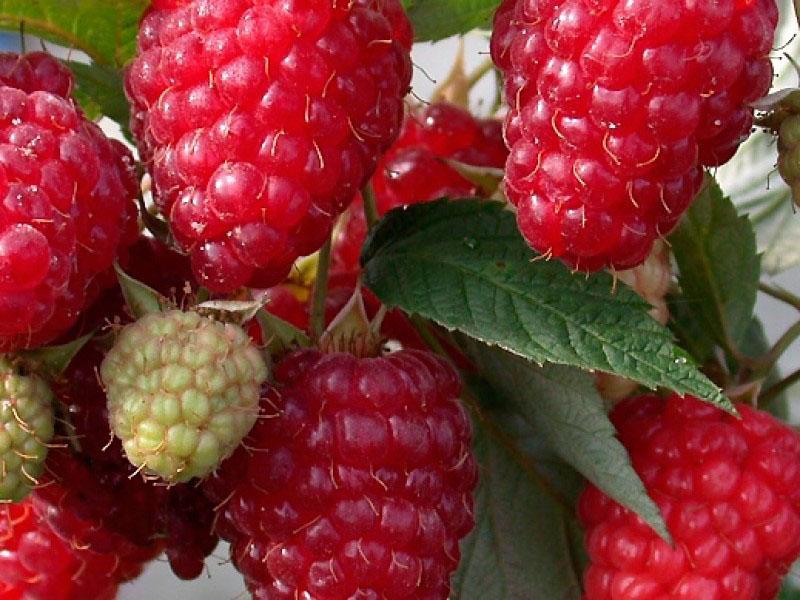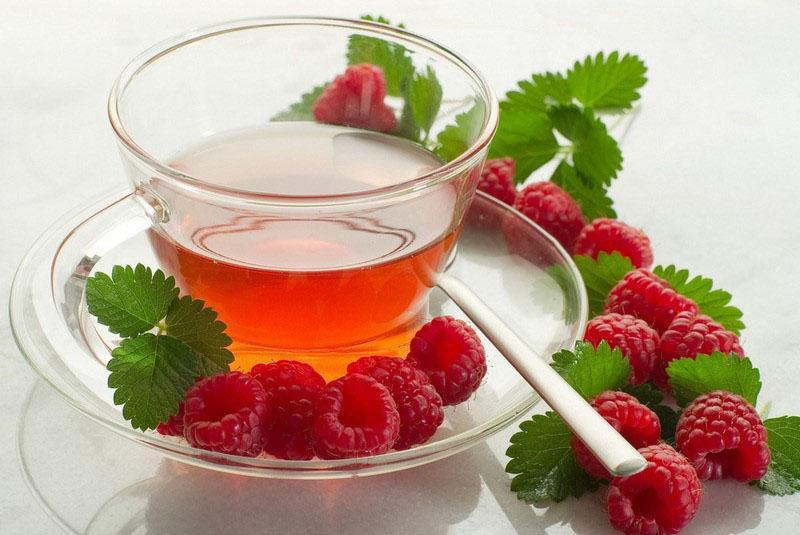How to plant raspberries in the fall to get the desired result
 Raspberry is a popular fruit shrub, it is often planted by lovers of this berry in their plots. How to plant raspberries - every experienced gardener knows, but some of the nuances may not be known to beginners. For proper growth, development and abundant fruiting, it is important to observe certain dates, choose a planting site, take into account the variety, and also prepare the soil.
Raspberry is a popular fruit shrub, it is often planted by lovers of this berry in their plots. How to plant raspberries - every experienced gardener knows, but some of the nuances may not be known to beginners. For proper growth, development and abundant fruiting, it is important to observe certain dates, choose a planting site, take into account the variety, and also prepare the soil.
Read:raspberry remontant care and cultivation.
Biological description of the culture

Central Europe is considered the birthplace of this plant. The natural habitat for raspberries is deciduous and coniferous forests, river banks and streams. In the wild, the plant inhabits the forests of northern and central Russia and the Siberian region, as well as the Caucasus, Central Asia, and the Carpathians.
Raspberry is a deciduous perennial shrub with a developed rhizome. Biennial shoots up to 2.5 m tall are formed from it. The root system of a woody structure, meandering, with a large number of adventitious roots, which form a branched system.
Raspberry stem is erect, young shoots of the first year of life are herbaceous, juicy, with a bluish tinge. In the second year of life, they acquire a brown color, sharp thorns. They dry up immediately after the end of the fruiting period. The following spring, the root system releases young stems again.
The leaf plates of the shrub are dense, bright green above, below - white, alternate, complex shapes. The flowers are white, collected in racemose inflorescences. Formed in the axils of the leaves and the tops of the stems.
Fruits are small rounded shoals with fine hairs. In the process of formation, they grow together on the receptacle into a complex fruit. The traditional color of the berries is red. However, there are yellow, white and black fruits. The shrub begins to bear fruit in the second year after planting, mainly in summer, but remontant raspberries bear fruit in the first year, including the autumn period.
Beneficial features
 The nutritional value of the berry and its beneficial properties are due to its rich vitamin composition. Raspberries contain vitamins A, E, C, PP, as well as a number of minerals: calcium, potassium, zinc, iron, magnesium, manganese and other components necessary for the vital functions of the body.
The nutritional value of the berry and its beneficial properties are due to its rich vitamin composition. Raspberries contain vitamins A, E, C, PP, as well as a number of minerals: calcium, potassium, zinc, iron, magnesium, manganese and other components necessary for the vital functions of the body.
The plant is also unique because all these substances perfectly complement each other, are well absorbed by the body, improving metabolism and enriching tissues with important components. Therefore, the shrub is used in folk medicine, cosmetology, and cooking.
Not only the fruits of raspberries have medicinal properties, but also the leaf plates of the plant.They also contain many useful substances, but it is recommended to collect the leaves and brew tea from them at the very beginning of summer.
The main varieties of raspberries
 Raspberries are divided into large-fruited, traditional, remontant varieties. Traditional varieties are distinguished by stable productivity, the ability to quickly adapt to environmental conditions, and undemanding to the soil. However, it is unlikely that it will be possible to collect a rich harvest from bushes with traditional varieties. While large-fruited raspberry varieties have the ability to branch out more, which ensures a good yield and large aromatic berries. Many gardeners, when planting remontant raspberry in the fall, two crops are harvested per season, starting from the first year of the shrub's life. Such specimens finish bearing fruit with the onset of frost.
Raspberries are divided into large-fruited, traditional, remontant varieties. Traditional varieties are distinguished by stable productivity, the ability to quickly adapt to environmental conditions, and undemanding to the soil. However, it is unlikely that it will be possible to collect a rich harvest from bushes with traditional varieties. While large-fruited raspberry varieties have the ability to branch out more, which ensures a good yield and large aromatic berries. Many gardeners, when planting remontant raspberry in the fall, two crops are harvested per season, starting from the first year of the shrub's life. Such specimens finish bearing fruit with the onset of frost.
When choosing varieties of raspberries, gardeners often specify the ripening time, and some prefer to plant several different shrubs in the plots at once in order to collect the berries as long as possible.
Early maturing crop varieties include:
- Cascade is a two-meter bush, often subject to spotting with errors in care, a bright red berry, with a sweet and sour taste;

- Vega - frost-resistant shrub, high resistance to diseases, the shape of the berry is blunt-conical, the taste is sweet and sour;

- Cumberland - moderate resistance to frost and disease, black fruits, arcuate stems, root shoots are not formed.

Among the remontant varieties, the following are common:
- Orange Miracle - a large berry with high palatability, bright yellow color;

- Brilliant - a shrub with a high yield, large ruby-colored berries;

- Monomakh's cap is a shrub for cultivation in central Russia, large fruits of dark red color, weighing up to 20 g.

The most popular late-ripening varieties include Mirage, Rubin, Capital variety. They are characterized by moderate disease resistance, stable fruiting. The bushes tolerate the cold season well, the shape of the berries is mainly blunt-conical or elongated, the color is red.
All raspberry varieties differ in a number of important characteristics - color, taste, planting and ripening times, resistance to pests and diseases, and the ability to survive the winter period.
How to plant raspberries in open ground
 The culture can be planted using different planting material. When choosing this or that method and material, you should know all the necessary subtleties of this process. You can plant raspberries using cuttings, layering, seedlings, and root cuttings and seeds are often used.
The culture can be planted using different planting material. When choosing this or that method and material, you should know all the necessary subtleties of this process. You can plant raspberries using cuttings, layering, seedlings, and root cuttings and seeds are often used.
Seedlings are usually purchased from specialized stores or nurseries. They are sufficiently formed and can exist separately from the mother bush. Due to the developed root system, seedlings root well when planted in open ground.
The pluses of planting seedlings include:
- high rate of growth and development of young culture;
- simple execution technique;
- early fruiting;
- minimal care after planting.
The sapling planting method also has some disadvantages. For example, there is a possibility of buying low-quality material, and also, if you plant raspberries in the fall, young roots can freeze in winter.
A great way to plant raspberries outdoors is with cuttings. It is used quite often by those gardeners who wish to expand the raspberry tree. All that is needed for this method is to properly prepare the cuttings, take into account the planting dates and provide the cuttings with competent care so that it takes root. This method is more suitable for experienced gardeners; for beginners, it may seem difficult.
Its possible disadvantages include:
- processing of planting material;
- transplant after rooting;
- difficulty in leaving after disembarkation;
- high risk of root damage.
Despite this, most gardeners use cuttings when propagating and planting raspberries, as there are several effective ways to harvest cuttings. In addition, the method allows you to obtain a large number of shoots that can be used.
Another method that causes a rather controversial attitude is planting a crop with seeds. It is recommended to use it only when there is confidence in the quality and origin of the material. The procedure can be carried out in the fall and spring, but for a spring planting, you will need to sow the material in pots and keep them in a warm room. One of the main advantages of this method is cost savings. The disadvantages are complex care after sowing, a long growing period before the first fruiting, a high risk of freezing.
How to plant raspberries: basic rules

In order for the shrub to develop and bear fruit well, a number of rules should be observed when planting:
- choose a place;
- take into account the terms;
- prepare the soil and planting material;
- determine the landing method.
Subsequent care for the planted plant is also important: watering regime and feeding, timely pruning and garter, preparation for the winter period.
Optimal planting times
 Many are interested in the question of when is it better to plant raspberries. The crop can be planted in spring and autumn. The only differences are in preparation for this procedure. In the spring, the plant is not yet fully ready for development, since sap flow has not yet begun. But on the other hand, at this time of the year the soil is already prepared, saturated with moisture from the snow. Warmed by the spring sun, the earth is able to give the culture everything it needs. However, it will be necessary to ensure that the young plant is not injured by direct sunlight.
Many are interested in the question of when is it better to plant raspberries. The crop can be planted in spring and autumn. The only differences are in preparation for this procedure. In the spring, the plant is not yet fully ready for development, since sap flow has not yet begun. But on the other hand, at this time of the year the soil is already prepared, saturated with moisture from the snow. Warmed by the spring sun, the earth is able to give the culture everything it needs. However, it will be necessary to ensure that the young plant is not injured by direct sunlight.
Another point is important when determining the timing of planting in the spring, when you can plant raspberries, taking into account the terrain and its climatic conditions. Of course, planting times vary from region to region. It is recommended to start the procedure in March in the southern regions of Russia, in April - in the Central region and the Moscow region, in early May - in the Urals and Siberia.
There is only one drawback of planting a bush in the spring, but very important - often gardeners wait for a stable above-zero temperature, missing the dates. This negatively affects the subsequent growth of the culture and its fruiting.
With the correct planting of raspberries in the fall, the plant tolerates the adaptation period easier. In this case, the most important thing is to plant more than a month before the first frost. The main advantage of autumn planting is that in the spring, at the first rays of the sun, raspberries begin to develop, and before the first frost the shrub will have time to take root.
Seat selection
 Despite the fact that raspberries can hardly be called a demanding plant, the choice of location should be taken seriously. This will affect the rooting, development and fruiting of culture in the future.
Despite the fact that raspberries can hardly be called a demanding plant, the choice of location should be taken seriously. This will affect the rooting, development and fruiting of culture in the future.
A place with the following characteristics is suitable for her:
- without drafts, with wind protection;
- with an abundance of sun, but slightly shaded for several hours a day;
- without groundwater;
- next to an apple, pear, plum.
Currant bushes will be a bad neighborhood for culture. You also need to plant raspberries where tomatoes, potatoes, strawberries have not previously grown, since they have a number of common diseases.
Soil preparation
 Preparing the soil before creating a raspberry tree is critical. The landing site must be prepared in advance - 2-3 weeks before the expected disembarkation. During this time, the soil will settle. Dig it up to a depth of 25-30 cm, select all roots and weeds. The best soil for raspberries is a well-drained sandy loam or loamy soil. If the culture will grow on sandy soils, then regular application of organic fertilizers and frequent watering will be required, since the sand does not retain moisture well. In heavy clay soils, it is recommended to make a dense drainage layer from crushed stone and broken brick.
Preparing the soil before creating a raspberry tree is critical. The landing site must be prepared in advance - 2-3 weeks before the expected disembarkation. During this time, the soil will settle. Dig it up to a depth of 25-30 cm, select all roots and weeds. The best soil for raspberries is a well-drained sandy loam or loamy soil. If the culture will grow on sandy soils, then regular application of organic fertilizers and frequent watering will be required, since the sand does not retain moisture well. In heavy clay soils, it is recommended to make a dense drainage layer from crushed stone and broken brick.
Planting raspberries in autumn
 When and how to plant raspberries in the fall depends on the planting method. There are several popular methods used by gardeners.
When and how to plant raspberries in the fall depends on the planting method. There are several popular methods used by gardeners.
One of the simple and effective ones is the bunch method. It is most commonly used by site owners, including newbies. It involves planting young plants in pre-prepared pits.
The step-by-step instructions are as follows:
- The markup is in progress. The distance between rows should be up to 2 m, between plants up to 1 m.
- Dig holes 0.5 m in diameter, up to half a meter deep.

- Pour into the bottom humus, superphosphate, potassium salt.

- Mix thoroughly using the topsoil.
- Place the plant in the center of the hole, and carefully spread the roots.

- When filling the space between the roots with soil, the seedling needs to be shaken periodically to fill the hole with soil more efficiently.
- Seal the hole and make a small depression for watering. It is important to keep track of the growth point - it should be at ground level.
- Water and mulch abundantly.

You cannot ignore such a process as mulching... This procedure is necessary to protect the soil and improve its properties. For mulching, use cut grass, straw, sawdust.
This method is suitable for those gardeners who do not have a place for a raspberry plant, and he needs to plant several raspberry bushes in different parts of the site.
There are other ways to book a raspberry tree. For example, trenching, which is considered the longest and most laborious. It is used when growing large quantities of raspberries, especially on a production scale.
 In small areas, the container growing method is used - in special containers or old tires.
In small areas, the container growing method is used - in special containers or old tires.
Planting raspberries is an important procedure. Before starting it, you need to learn about all the possible nuances in order to eventually grow a healthy shrub with abundant fruiting. The main thing is to take into account the planting dates, choose the desired variety and prepare the planting material, as well as observe the basic rules for planting raspberries.